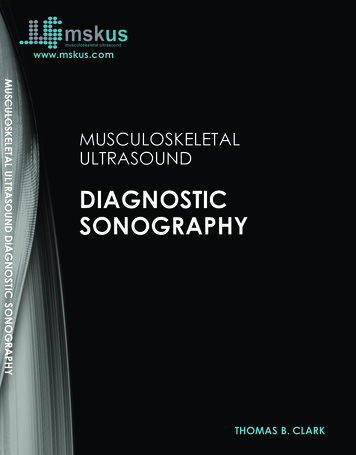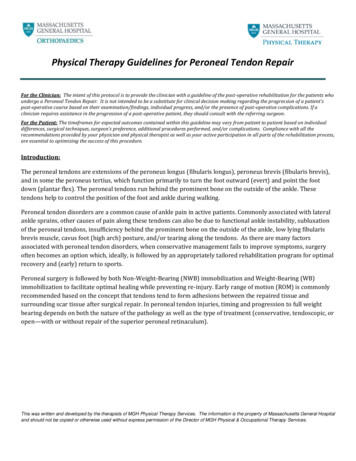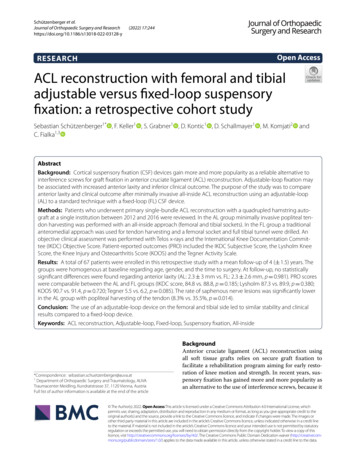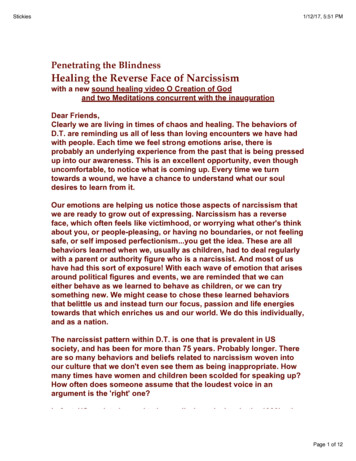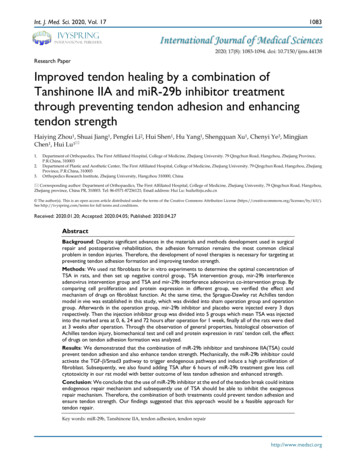
Transcription
Int. J. Med. Sci. 2020, Vol. 17IvyspringInternational Publisher1083International Journal of Medical Sciences2020; 17(8): 1083-1094. doi: 10.7150/ijms.44138Research PaperImproved tendon healing by a combination ofTanshinone IIA and miR-29b inhibitor treatmentthrough preventing tendon adhesion and enhancingtendon strengthHaiying Zhou1, Shuai Jiang1, Pengfei Li2, Hui Shen1, Hu Yang1, Shengquan Xu1, Chenyi Ye3, MingjianChen1, Hui Lu1 1.2.3.Department of Orthopaedics, The First Affiliated Hospital, College of Medicine, Zhejiang University. 79 Qingchun Road, Hangzhou, Zhejiang Province,P.R.China, 310003Department of Plastic and Aesthetic Center, The First Affiliated Hospital, College of Medicine, Zhejiang University. 79 Qingchun Road, Hangzhou, ZhejiangProvince, P.R.China, 310003Orthopedics Research Institute, Zhejiang University, Hangzhou 310000, China Corresponding author: Department of Orthopaedics, The First Affiliated Hospital, College of Medicine, Zhejiang University,79 Qingchun Road, Hangzhou,Zhejiang province, China PR, 310003. Tel: 86-0571-87236121; Email address: Hui Lu: huilu@zju.edu.cn The author(s). This is an open access article distributed under the terms of the Creative Commons Attribution License (https://creativecommons.org/licenses/by/4.0/).See http://ivyspring.com/terms for full terms and conditions.Received: 2020.01.20; Accepted: 2020.04.05; Published: 2020.04.27AbstractBackground: Despite significant advances in the materials and methods development used in surgicalrepair and postoperative rehabilitation, the adhesion formation remains the most common clinicalproblem in tendon injuries. Therefore, the development of novel therapies is necessary for targeting atpreventing tendon adhesion formation and improving tendon strength.Methods: We used rat fibroblasts for in vitro experiments to determine the optimal concentration ofTSA in rats, and then set up negative control group, TSA intervention group, mir-29b interferenceadenovirus intervention group and TSA and mir-29b interference adenovirus co-intervention group. Bycomparing cell proliferation and protein expression in different group, we verified the effect andmechanism of drugs on fibroblast function. At the same time, the Sprague-Dawley rat Achilles tendonmodel in vivo was established in this study, which was divided into sham operation group and operationgroup. Afterwards in the operation group, mir-29b inhibitor and placebo were injected every 3 daysrespectively. Then the injection inhibitor group was divided into 5 groups which mean TSA was injectedinto the marked area at 0, 6, 24 and 72 hours after operation for 1 week, finally all of the rats were diedat 3 weeks after operation. Through the observation of general properties, histological observation ofAchilles tendon injury, biomechanical test and cell and protein expression in rats’ tendon cell, the effectof drugs on tendon adhesion formation was analyzed.Results: We demonstrated that the combination of miR-29b inhibitor and tanshinone IIA(TSA) couldprevent tendon adhesion and also enhance tendon strength. Mechanically, the miR-29b inhibitor couldactivate the TGF-β/Smad3 pathway to trigger endogenous pathways and induce a high proliferation offibroblast. Subsequently, we also found adding TSA after 6 hours of miR-29b treatment gave less cellcytotoxicity in our rat model with better outcome of less tendon adhesion and enhanced strength.Conclusion: We conclude that the use of miR-29b inhibitor at the end of the tendon break could initiateendogenous repair mechanism and subsequently use of TSA should be able to inhibit the exogenousrepair mechanism. Therefore, the combination of both treatments could prevent tendon adhesion andensure tendon strength. Our findings suggested that this approach would be a feasible approach fortendon repair.Key words: miR-29b, Tanshinone IIA, tendon adhesion, tendon repairhttp://www.medsci.org
Int. J. Med. Sci. 2020, Vol. 17BackgroundTendon is a highly organized tissue that connectsmuscle to bone and facilitates joint movements. Dueto overuse or aging-related degeneration, tendoninjuries become one of the most common clinicalproblems (1, 2), while tendon healing is a complexprocess which mainly involving both endogenous andexogenous mechanisms (3). Despite advances in thematerials and methods used in surgical repair andpostoperative rehabilitation (2), tendon adhesion isconsidered as the significant problem during theprocessing of wound healing after surgery (4). Studieshave been shown that inflammation at the early stageof healing is the leading cause of soft tissue adhesion(3, 5, 6). Also, tendon healing usually cannot fullyrestore normal tendon strength and results insignificant weakness (7). There are many biologicalmaterials have been evaluated to prevent tendonadhesion, such as amniotic membrane and seprafilm.However, the common problem is that those materialsinduce inflammation and have very poor cellularity(8, 9). Also, several non-steroidal anti-inflammatorydrugs such as ibuprofen have been evaluated fromtendon injury treatment (10, 11). However, due totheir complexity and restriction of tendon adhesion,reliable therapies are still missing. Therefore, it isnecessary to develop new practical approaches fortendon healing.Tanshinone IIA (TSA) is a member of the mostabundant lipophilic components extracted from Salviamiltiorrhiza (12). Studies have been shown that TSAhas anti-inflammatory activity and has been widelyused for various diseases (13, 14). In our recent studiesand others demonstrated that TSA could effectivelyprevent tendon adhesion through interaction withTGF-β/Smad signaling pathway (12, 15). However,studies have not investigated the treatment effects ontendon strength. Many studies have shown thatmicroRNA is emerging as vital homeostatic regulatorsof tissue repair (16). The miRNA-29 (miR-29) plays animportant role in the regulation of key process offibrosis and scar formation (17). In our previousstudy, we also found that TSA treatment enhancedthe expression level of miR-29b (12). Indeed, themiR-29b has been shown to play an important role inmany different diseases such as diabetes, cancer, andheart. In particular, previous studies found thatmiR-29b is a downstream inhibitor of TGF-β/Smad3mediated fibrosis and treatment of miR-29b hadtherapeutic potential for disease associated withfibrosis (15, 18-21). In summary, previous studieshave shown that the miR-29b can prevent tendonadhesion through downregulation of the TGF-β1 andSmad3 expression and TSA can inhibit TGF-β1 to1084prevent tendon adhesion as well. As we justmentioned that tendon healing involved bothendogenous and exogenous mechanisms.We hypothesized that the use of miR-29binhibitor at the end of tendon break could initiateendogenous repair mechanism and subsequently useof TSA should be able to inhibit exogenous repairmechanisms, therefore prevent tendon adhesionwhile ensuring tendon strength. By using SpragueDawley rat model, we demonstrated that thecombination of miR-29b inhibitor and TSA treatmentnot only prevent the tendon tissue adhesion but alsoincrease tendon strength.Materials and MethodsEstablishment of rat tendon modelAll animal experiments were approved byanimal committee for ethics of laboratory animalresearch center, First Affiliated Hospital, College ofMedicine, Zhejiang University and the animalexperiment procedures were approved by theInstitutional Animal Care and Use Committee, FirstAffiliated Hospital, College of Medicine, ZhejiangUniversity. The rat model of adhesion of tendon waseatablished as in our previous studies (12, 15). Briefly,rats were anesthetized using halothane (50 mg/kgweight). Under general anesthesia, a longitudinalincision was made from the heel to hind paw under acontrol tourniquet. Achilles tendon was half partiallacerations involved approximately 50% of tendonfibers. The tendon was repaired by a modifiedKessler’s technique with 5-0 Ti-Cron coated braidedpolyester sutures (COVIDIEN, USA). Then the tendonsheath was closed with the same sutures. The skinwas closed with 5-0 Surgipro monofilamentpolypropylene (COVIDIEN, USA). After surgery, ratswere allowed to perform free active motion andregular weight-bearing.Isolation of fibroblastsScar tissues of repaired tendon sites from MaleSprague-Dawley rat hind paws were dissected outand placed into laminar flow cabinet and minced into5mm tissue pieces and seeded into a petri dish.Fibroblasts can be isolated in D10 medium containing10% fetal bovine serum, 1% Penicillin/streptomycin,and 200U/ml collagenase in DMEM medium. Thesuspension was filtered to get fibroblast cells and thencultured with D10 at 37 C.MTT assayThe cytotoxicity of Tanshinone IIA wasdetermined using the MTT assay. Fibroblast cellswere resuspended into 5 x104 cell/ml and put 100µl ofthe cell suspension to the 96-well plates. The cellshttp://www.medsci.org
Int. J. Med. Sci. 2020, Vol. 17were cultured overnight, and TSA at variousconcentrations was added to the culture ranging from0, 0.001, 0.01, 0.1, 1,10 and 20 μM, respectively. Thenthe cells were further incubated for 24 hours. Afterincubation, the supernatant was removed, 100 μl ofDMSO was added to each well and incubated for 10min. A microplate reader was used to measure at 570nm. All experiments were performed in triplicate. Theviability was calculated using the formula: % viability value of treated cells/ value of control cells x 100%.CCK-8 assayRat fibroblasts in logarithmic growth phase wereinoculated in 96-well plate, with the amount of 100 μlper well and the cell suspension density of 5 104/ml.The cells were treated with DMSO, scramble siRNAcontrol, miR-29b shRNA, TSA, scramble siRNAcontrol and TSA, miR-29b shRNA and TSA,respectively. μl of CCK-8 was added to each well(Beyotime). After 4 h of incubation, the OD450 valuewas measured by spectrophotometer. Viability (%)was calculated based on the optical density (OD)values, as follows: (OD of TSA treated sample - blank)/ (OD of control sample - blank) 100.TUNEL assayThe tissue from rat model under aldehyde in PBS, permeabilized by 0.1%Triton X-100 and followed by treating with TUNELreagent (Beyotime Institute of Biotechnology,Haimen, China) and then, incubated for 30 min atroom temperature. Images were captured using aBX53 microscope (Olympus Corporation, Tokyo,Japan). The cell nuclei were stained with Alexa Fluor647 and DAPI. The percentage of TUNEL-positivecells in the total cell population was calculated.Quantitative Real-time Polymerase ChainReactionTotal RNAs was extracted from primaryfibroblasts or rat tissue using TRIzol (Invitrogen)according to the manufacturer’s instructions. Then,1-2µg of total RNA was reverse transcribed using aHiScript Reverse Transcriptase (Vazyme), and thenthe cDNA was quantified using the SYBR Green Iwith Taq Plus DNA Polymerase. After a circlereaction, the threshold cycle (Ct) was determined, andthe relative expression levels of TGF-β1, Col1, Col3,Cyclin D, p21, Smad3 were calculated based on the Ctvalues normalized to GAPDH in each sample. Therelative expression of miR-29b was detected using aBulge-Loop miRNA qRT-PCR kit (RiboBio) with U6as the internal control. The sequences of the primersin this study were shown in Table S1.1085Western BlotFor western blot analysis, total proteins wereextracted from tissues or primary fibroblasts. TheBCA(bicinchoninic acid) method was used to qualifythe amount of protein with BSA standard. A total of40 µg of protein was fractionated on a 12%SDS-polyacrylamide gel and transferred to apolyvinylidene fluoride membrane (PVDF). Themembrane was then blocked with 5% milk in aTris-buffered saline solution (TBST) for 2 hours atroom temperature. The primary antibodies, TGF-β1(1:1000; Abcam), p21 (1:1000; Abcam), Smad3(1:1000,Abcam), pSmad3 (1:3000, Cell Signaling) and GAPDH(1:1000; Xianzhi Bio, Hangzhou, China) were usedand incubated overnight at 4 C, followed byincubation with horseradish peroxidase (HRP)–conjugated secondary antibody (1:50,000, Boshida,Wuhan, China). The proteins were visualized, andband density was quantified by using BandScansoftware.Transfection ProcedureThe transfection procedure was performed usingLipofectamine 3000 according to the manufacturer’sinstructions. Briefly, the cells were washed withserum-free and antibiotics-free DMEM and thenreplaced with serum-free and antibiotics-free DMEMfor 6 hours prior to transfection. The miRNA mimicsor miRNA inhibitor (RiboBio, Guangzhou, China) andLipofectamine 3000 (Invitrogen) were separatelymixed using Opti-MEM medium (Gibco, China) for 5minutes, then two components were subsequentlymixed and further incubated at RT for 20 minutes. TheDNA-lipid mix was added to the cells and furthercultured for 6 hours. Fresh medium was replaced after6 hours of incubations with transfection reagents.Annexin V assayTo determine cell apoptosis in primaryfibroblasts cells under different treatment conditions,we performed Annexin V staining. The samples werestained with 5ul of Annexin V (APC) for apoptoticcells and 5ul of 7-AAD for dead cells. The cells werewashed and analyzed by flow cytometry usingcytoFlex (Beckman coulter).Cell Cycle AnalysisThe cell cycle was analyzed by flow cytometry.Briefly, primary fibroblast cells were treated underdifferent conditions was used for analysis. Aftertreatment, cells were collected and washed twice withice-cold 1 PBS, suspended in 700µl of pre-cooled80% alcohol, and fixed the cells at 4 C for 4 hours. Thecells were then stained with the Cell cycle kit (Keygen,http://www.medsci.org
Int. J. Med. Sci. 2020, Vol. 17Nanjing, China). The cells were washed and analyzedby flow cytometry using cytoFlex (Beckman coulter).Histological assessment and Masson trichromestainingThe rats were sacrificed 3 weeks after surgery,and the harvested specimens were immediately fixedin 4% paraformaldehyde, dehydrated in ethanol andthen embedded in paraffin blocks. Histologicalsections (4μm) were prepared for hematoxylin andeosin staining (H&E). The quantity and ratio offibroblast-like cells within the repaired tissue wereassessed. Also, Masson trichrome staining wasperformed according to standard procedures toexamine the general appearance of collagendeposition and collagen fibers.Rat animal model experimentWe selected 8-week-old male SD rats for theexperiment, 5 rats in each small group. Firstly, wedivided rats into sham operation group (5 rats) andoperation group (25 rats). After the Achilles tendoninjury model was established in the operation group,there were two different treatment one (20 rats) wasmiR-29b inhibitor and the other (5 rats) was negativecontrol, things were injected every three days. Then inthe inhibitor group, there were four different injectiontime which divided them in four small group, and thedrugs of TSA were injected at 0h, 6h, 24h and 72h,respectively through the marker area for 1 week.Three weeks later, the rats were sacrificed, Achillestendon defects of 6 mm in length were generated byfull-thickness cut-outs in SD rats. The biomechanicaltest was performed using a universal tensile testmachine at a rate of 5mm/min until failure, and thehistological and protein expression changes weredetected by the above methods.Statistical analysisData were expressed as mean Standard error.Statistical significance was determined by two-wayANOVA with Tukey multiple comparisons test anddefault setting. A p-value less than 0.05 wereconsidered significantly different. All the graphsstatistics were analyzed by GraphPad prism version8.2.1.441. The figures were prepared by adobeillustrator 2019.ResultsTSA and miR-29b inhibitor demonstratedopposite effects on tendon adhesionIn our recent study using Sprague-Dawley ratmodel, we demonstrated that TSA treatment couldprevent tendon adhesion but fail to enhance thetendon strength (12, 15). To test whether using a1086combination of TSA and miR-29b inhibitor couldresult in better treatment of tendon adhesion andenhance tendon strength through modulatingendogenous and exogenous repair pathways, we firsttested on primary fibroblast cells in vitro isolated fromthe rat. The MTT results indicated that TSA at 1μMsignificantly reduced cell viability after 24 h oftreatment. Hence, we use 0.1μM TSA in this study(Figure 1A). We next investigated the effects of bothTSA and miR-29b inhibitor treatment using primaryrat fibroblast cells. The shRNA silencing of miR-29bclearly showed downregulation of miR-29b infibroblast cells, and treatment of TSA significantlyenhanced the expression of the miR-29b, which wasconsistent with our previous studies (12, 15).Strikingly, simultaneous treatment of cells with TSAand miR-29b shRNA counteract the effects of thetreatment showing that there are no significantchanges of miR-29b in double-treated samples (Figure1B). Our previous studies showed treatment with TSAalone could prevent tendon adhesion throughTGF-β/Smad signaling pathway, therefore, weinvestigated the dynamic changes of TGF-β and Smadexpression in both mRNA and protein level underdifferent treatment conditions. Consistent with ourprevious study, we found that TSA treatmentdecreased the expression of both TGF-β and Samd3level. In contrast, the miR-29 inhibitor significantlyupregulated the expression of both TGF-β and Smad3(Figure 1C-D and Figure S1A). Strikingly, when thecells treated with both TSA and miR-29 inhibitor atthe same time, we observed that the expression levelof TGF-β and Samd3 were significantly higher thanTSA treated only, but significantly attenuatedcompared to the sample treated with miR-29binhibitor. Our findings confirmed that both TSA andmiR-29b inhibitor target the same pathway implyingthat the combination could trigger endogenouspathways and manipulate late stage of targeting atexogenous pathways.Effects of TSA and miR-29b on cellproliferation and cell cyclesTo test the capability using the combination ofTSA and miR-29b inhibitor for treatment, we furtherinvestigated the cytotoxicity effects and cellproliferation in primary cell models. The CCK-8 assaydemonstrated that cells treated with miR-29binhibitors significantly increased cell proliferation(Figure 2A), while TSA treated cells significantlydecreased cell proliferation compared with no treatedcells which are consistent in our previous study(Figure 2A). Interestingly, when the cells treated withboth TSA and miR-29b inhibitor, we found that cellproliferation ability was significantly decreased whenhttp://www.medsci.org
Int. J. Med. Sci. 2020, Vol. 17compared with the miR-29b inhibitor only and higherthan the TSA treated cells. The same trends wereobserved in cell apoptosis analysis which meanopposite result of apoptosis compared with cellproliferation in three treatment group, these furthersuggesting the antagonistic effects of TSA andmiR-29b inhibitor. It has been described that thedynamics of cell growth in different treatment1087conditions may result from cell cycles, cell death, or acombination of these two processes. Thus, we nextinvestigated the cell cycle distribution and cellapoptosis under different conditions by fluorescenceactivated cell sorting (FACS) analysis, which gives ameasure of DNA content, to explore the relatedmechanism of the growth dynamic for each differenttreatment.Figure 1: The dynamic changes of miR-29b, TGF-β, and Smad under miR-29b inhibitor and TSA treatment. A: the cytotoxicity of TSA was determined by MTT assay. B: miR-29expression was measured by qPCR. C: both mRNA and protein expression level of TGF-β were measured under different conditions. D: the Smad mRNA expression wasmeasured by qPCR (n 3) and protein expression level (n 1) were measured by western blotting under different conditions., p-value * 0.05, ** 0.01, *** 0.005, **** 0.001http://www.medsci.org
Int. J. Med. Sci. 2020, Vol. 171088Figure 2: Effects of cell proliferation, apoptosis, and cell cycles under miR-29b inhibitor and TSA treatment. A: cell proliferation was performed by CCK8 kit. B: Annexin V andPI staining were performed by FACS. The summarized results were shown here. C: Cell cycle analysis of primary isolated cell treated under different conditions. Cells werecultured with different concentrations of TSA for 24 h and then stained with propidium iodide. The DNA content was analyzed by flow cytometry. n 3, p-value * 0.05, ** 0.01,*** 0.005, **** 0.001As shown in Figure 2C, the TSA treated cellsexhibited a higher proportion of cells in the G1 phase,while the TSA induced higher cell apoptosis ascompared with control cells. Besides, we observed aconcomitant decrease in the proportion of cells in theG2 and S phase in the TSA treated groups comparedwith the miR-29b inhibitor-treated ones (Figure S1Band 1C). At the same time, when the cells were treatedwith both TSA and miR-29b inhibitor, we alsoobserved that cell apoptosis was significantly reducedand had slightly higher proportion of cells in the G1phase compared to TSA treated only, but opposite tomiR-29b inhibitor treated only. In sum, the resultssuggested that miR-29b was able to increase cellproliferation and TSA treatment could reduce thoseeffects.The combination of TSA and miR-29binhibitor treatment increase cell proliferationOur in vitro primary cell results demonstratedthat treatment of TSA could reduce the expression ofTGF-β and Smad3, and alter the cell proliferation andapoptosis, in contrast, the miR-29b inhibitor treatmentshowed the opposite effects. However, when treatedcells by using the combination of TSA and miR-29binhibitor, we clearly observed antagonistic effectssuggesting that we could first treat cells with themiR-29b inhibitor to enhance endogenous repairpathway and then followed with the TSA treatment toreduce the tendon adhesion formation. The maleSprague-Dawley rat animal model was used to testthe hypothesis, the rat was treated with or withoutmiR-29b inhibitor to induce endogenous repair, andthen, the TSA was added at different time-points asindicated in Figure 3. We first investigated the efficacyof miR-29b inhibitor in our rat model, and the resultsindicated that all inhibitor treatments significantlysuppressed the expression of miR-29b RNA comparedwith untreated control as shown in Figure 3A.Besides, we investigated the cytotoxicity of the TSAand miR-29b inhibitor in different treatmentconditions. Our results demonstrated that thecombination of TSA and miR-29b inhibitor treatmentssignificantly decreased the number of apoptotic cells.Strikingly, we observed that the rat treated withmiR-29b inhibitor first and followed by TSA after 6hours showed slightly lower level of apoptotic cellscompared with other treatment while closed tocontrol rat groups suggesting that different treatmenttime-point could result in distinct treatment effects.http://www.medsci.org
Int. J. Med. Sci. 2020, Vol. 171089suggesting that the treatment might not heal thetendon completely which needed to be furtherinvestigated in more details.Effects of Treatment of TSA and miR-29binhibitor on collagen expression and fibroblastproliferationPrevious studies have shown that fibroblastproliferation and collagen I and III (Col I/III)expression are the two major factors contributing tothe formation of tendon adhesions (22, 23). Therefore,we next tested the expression level of Col I/Col IIIand Cyclin D to look at collagen expression andfibroblast proliferation (Figure S3). We observed thatCol I and Col III showed opposite trends whichshowed that the protein levels of Col I increased whendelayed the addition of TSA treatment, while thecyclin D showed the significant increase compared tocontrol group but no differences among diseasemodel groups (Figure 5A-C). We next evaluated thehistological repaired tissue by HE and Massonstaining (Figure S2). Among all groups, we observedthat fibroblasts and collagenous tissue proliferated atthe repaired site compared with the untreated control,and furthermore, the number of collagen fiber andfibroblast increased and well arranged in the grouptreated miR-29b inhibitor and TSA (Figure 5D).Effects of Treatment of TSA and miR-29binhibitor on tendon strength and adhesionFigure 3: The rat model was established and treated with the different condition asdescribed from Group 1 to 6. The rat was then sacrificed after three-week aftertreatment. A: the miR-29b expression was quantified by qPCR, and the result wasnormalized to the control group. B: TUNEL assay was performed to investigate thefrequency of apoptotic cells. n 3, p-value * 0.05, ** 0.01, *** 0.005, **** 0.001Both TSA and miR-29b inhibitor regulatedTGF-β/Smad3 pathwayOur previous study and in vitro data suggestedthat both TSA and miR-29b inhibitor treatment werethrough TGF-β1/Smad3 pathway. We nextinvestigated that molecular mechanism of TSA andmiR-29b inhibitors in the rat model. The expressionlevel of TGF-β, p21 and Smad3 were measured atmRNA and protein levels under different treatmentconditions. We observed that the expression wasconsistent in both mRNA and protein level, showingthat treatment decreased the level of TFG-β andSmad3 level (Figure 4A-C). However, the TGF-β andSmad3 level still higher than healthy control,We next evaluated the standard degree ofadhesion according to the previous study (12). Theresults indicated that the combination of treatmentreduced tendon adhesion (Figure 6A). Moreover, thetendon strength under different treatment wasevaluated in the current study (Figure 6B). Our resultsindicated that all treatment conditions resulted inhigher maximum loads than disease model,suggesting that early induce endogenous repairmechanism could increase the tendon strength; andthat there is no adverse effect on tendon adhesion.DiscussionIn this study, we investigated the treatmenteffects on tendon adhesion and healing using in vitroand in vivo model treated with the combination ofmiR-29b inhibitor and TSA, we showed that usingmiR-29b inhibitor could increase cell proliferation andalso active TGF-β/Smad3 pathway to enhance theendogenous healing processes and the followed TSAtreatment could negatively modulate the TGF-β/Smad3 pathway to prevent tendon adhesionformation.Tendon healing is a complex clinical processinvolving simultaneous endogenous and exogenoushttp://www.medsci.org
Int. J. Med. Sci. 2020, Vol. 17repair. Tendon adhesion is regarded as one of themost significant problems of wound healing aftersurgery (12, 14, 24). Tendon healing typically includedexogenous and endogenous healing mechanisms.Endogenous healing mainly involves in inducingtenocytes proliferation and exogenous healing occursthrough the chemotaxis of specialized fibroblasts andinflammatory cells from the periphery, blood vessels,and circulation into the defect from the ends of thetendon sheath. The tendon strength is heavilydepending on endogenous healing mechanisms,1090while the exogenous mechanism is the main probleminduce tendon adhesion (25, 26). In general, theexogenous pathway is induced earlier thanendogenous pathway because endogenous pathwayhappened as early as 24 hours (27). Previous studieshave been mainly focused on how to modulateexogenous pathway while haven’t paid muchattention to endogenous pathway1. Therefore, in ourcurrent study, we used both miR-29b inhibitor andTSA combination aim to address this issue.Figure 4: The effects of under miR-29b inhibitor and TSA treatment on TGF-β, p21, and Smad3 expression. A: the TGF-β mRNA expression was measured by qPCR and proteinexpression level were measured, n 3. B: the p21 mRNA expression was measured by qPCR and protein expression level were measured, n 3. C: the Samd3 mRNA expressionwas measured by qPCR and protein expression level were measured, n 3, p-value * 0.05, ** 0.01, *** 0.005, **** 0.001http://www.medsci.org
Int. J. Med. Sci. 2020, Vol. 171091Figure 5: Analysis of tendon tissue on collagen expression and histology changes. The collagen I expression level was measured by immunohistochemistry in each group at threeweeks. A: the production of collagen I in different groups B: the production of collagen III, C: Hematoxylin & Eosin (H&E) staining (upper panel) and Masson staining (lower panel)on tendon tissue of rats in various groups ( 200). D: the expression of cyclin D: histological evaluation of tendon tissue at weeks 3 in each group. n 3, p-value * 0.05, ** 0.01,*** 0.005, **** 0.001TSA is an effective component of Salviamiltiorrhiza, a plant of Salvia in Labiatae, which hasantibacterial, anti-inflammatory, vasodilative and antiplatelet aggregation functions. It has been proved tobe closely related to tissue fibrosis (28, 29). In theHepatic fibrosis model of mice that was induced byintraperitoneal injection of thioacetamide (TAA), thetreatment of TSA lead to the lower expression ofalpha-SMA, collagen I, TGF-beta1, Smad3 and IGFBP7in liver, which implicated that TSA could improveliver function and inhibit the fibrosis throughblocking TGF-β1/Smad3 signaling pathway(30). Atthe same time, researchers (31) found that TSA couldplay as an antioxidant in the high glucose culturedcardiac fibroblasts, where it could inhibit theTGF-β1/Smad to reduce the high glucose-mediatedcollagen synthesis, and ultimately inhibit myocardialfibrosis. Wang et al. (32) confirmed that TSA canreduce renal fibrosis and inflammation in rats after5/6 nephrectomy by regulating TGF-β1/Smad3 andNF-κB pathway. Meanwhile, sodium tanshinone IIAsulfonate (33) can improve the bladder fibrosis in ratswith partial bladder outlet obstruction by inhibitingthe activation of TGF-β/Smad pathway.There are many microRNAs have been describedinvolved in tendon injuries such as miR-210 whichcould improve tendon injury healing via regulation ofangiogenesis and miR-29b that could prevent tendonadhesion. Also, the miR-29b has been shown to playan essential role in different diseases such as diabetes,cancer, and heart (34-36). In particular, our previousstudy showed that TSA treatment prevented tendonad
respectively. Then the injection inhibitor group was divided into 5 groups which mean TSA was injected into the marked area at 0, 6, 24 and 72 hours after operation for 1 week, finally all of the rats were died at 3 weeks after operation. Through the observation of general properties, histological observation of





